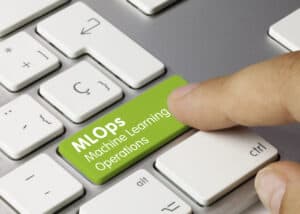
By integrating MLOps practices, financial institutions can overcome hurdles related to model scalability, reliability, transparency, fairness, and compliance instilling trust among stakeholders and regulators.
For financial institutions to fully embrace the potential benefits of Machine learning (ML) and artificial intelligence (AI), many hurdles must be overcome. These challenges include issues such as data quality, AI/ML model explainability, and the critical concerns of bias and fairness. By addressing these obstacles, MLOps (Machine Learning Operations) can truly shine.
Like many industries, ML and AI are transforming how the finance sector operates – from enhancing the customer experience, detecting and preventing fraud, to improving risk management and streamlining loan applications. It’s estimated around 32% of banks are already using AI technologies, such as predictive analytics and voice recognition, with the global AI in banking market set to grow to $64.03 billion by 2030.
MLOps can address some of these challenges faced by financial institutions when implementing AI in banking by providing a systematic approach to managing the lifecycle of ML models. MLOps focuses on boosting collaboration between the different teams involved in AI/ML, such as data scientists, developers and IT operations teams.
MLOps provides a framework for managing and optimizing the entire ML lifecycle, from development to deployment and monitoring. It ensures that models are built with the right data, deployed effectively, and continuously monitored to maintain their performance. Embracing MLOps practices empowers banks to elevate their AI capabilities. It ensures higher code quality, enables faster and more efficient patching, upgrades, and updates, streamlines releases, and ultimately builds trustworthy and scalable AI in banking.
Key areas include fighting fraud in real-time and increasing personalization, but let’s start by digging in on transforming credit risk assessments.
See also: What Is MLOps and How Will It Change the Data Center?
Transforming credit risk assessments
Credit risk has always been a challenging area for banks, given the multiple factors that form an individual’s risk profile. Credit risk assessment involves analyzing a borrower’s credit history, financial statements, and other relevant data to determine their ability to repay a loan. AI/ML are changing the way credit risk is assessed, with ML models getting increasingly accurate with each round of training.
However, ML models may still contain assumptions that can pose a significant challenge when analyzing noisy historical financial data and may lead to poor model performance. There’s also a risk of overfitting the data, as ML models are more sensitive to outliers than traditional analytics. Feature engineering involves selecting and engineering the features that will be used in the ML model. MLOps can help banks and financial institutions to help automate this process and ensure that the features are selected based on their relevance to the credit risk assessment task.
Despite their potential benefits, AI/ML models used in credit risk assessment face a critical challenge—bias. AI/ML models can inadvertently reflect biases and prejudices that exist in the data used to train them, leading to unfair or discriminatory outcomes. Addressing this issue is essential for maintaining fairness and ensuring ethical practices in lending.
By leveraging MLOps, banks can detect and address biases in the data used to train the models thereby mitigating bias and promoting fairness in credit risk assessment models. MLOps enables thorough testing on diverse and representative datasets, ensuring that the models are not skewed towards any particular group or demographic. MLOps practices facilitate continuous monitoring and evaluation of the credit risk assessment models. This ongoing monitoring allows banks to identify and rectify any biases that may emerge over time, ensuring that the models remain fair and objective throughout their lifecycle.
Additionally, MLOps supports compliance efforts, enabling banks to adhere to regulatory guidelines and promote responsible lending practices.
Fighting fraud in real-time
Fraud poses a persistent and significant challenge for financial institutions worldwide, demanding early detection to mitigate losses and safeguard customers. To combat this rising threat, banks and financial institutions are increasingly leveraging AI-powered fraud detection models capable of analyzing extensive datasets.
AI-powered fraud detection operates in real-time, continuously monitoring transactions and activities as they occur. This instantaneous analysis enables swift identification of potential fraud, allowing financial institutions to take immediate action to prevent losses and protect customers. AI models not only detect ongoing fraud but can also assist in preventing fraudulent activities. By analyzing historical fraud data and patterns, AI systems can identify potential vulnerabilities and recommend proactive measures to strengthen security controls, reduce risks, and prevent fraudulent incidents before they occur.
The process of developing and deploying a fraud detection model involves several steps – all of which can be supported by MLOps. MLOps can help data science teams to automate the process of collecting and preparing data to be used in a model. It can also ensure models are developed in a consistent and reproducible manner, using best practices for data analysis and feature selection. Once in the production environment, MLOps can ensure the model is deployed in a scalable and reliable way, with teams able to monitor the performance of models to detect any issues and make the necessary changes to improve performance.
Increasing personalization
Many banks have made substantial investments in AI, but they often struggle to achieve a significant return on their investment. This can be attributed to several factors, including inconsistent customer data, limited knowledge sharing, and AI models with narrow scopes or limited replicability. To address this issue, banks must improve their ability to develop a comprehensive suite of machine learning (ML) models capable of driving personalized engagement at every customer touchpoint.
Currently, many ML models in banking are trained on isolated moments, focusing on short-term, product-driven objectives like increasing mortgage applications or account openings. However, to truly harness the power of AI for personalization, banks need to shift their focus towards identifying the drivers of customer lifetime value and shaping customer interactions based on those insights.
MLOps can help ensure that the model is developed using best practices for data analysis, feature selection, and model training. In most cases, ML models and campaign-management systems often lack feedback loops to connect them, resulting in banks being unable to apply predictive insights from their ML models to inform campaign execution and decision-making. MLOps promotes collaboration between data scientists and various operations teams, helping to ensure that banks can confidently apply predictive insights to decision-making and create personalisation programmes.
The future of MLOps
No doubt about it, the financial services sector will benefit greatly from the accelerated adoption of AI. We’ve covered just some of the areas where AI can create transformative impacts. By integrating MLOps practices, financial institutions can overcome hurdles related to model scalability, reliability, transparency, fairness, and compliance instilling trust among stakeholders and regulators. Through automation and streamlined processes, MLOps reduces the time and effort required to develop, deploy, and maintain AI models, driving operational efficiency and cost-effectiveness. In conclusion, the adoption of MLOps in financial services is poised to play a pivotal role in accelerating AI adoption at scale.




























